As my husband, Michael, and I look back on the years we lived in France, one of the greatest blessings was to have been “adopted” into a French family and to be transformed by affection, camaraderie, and wit spanning four generations.
It all began when Caroline, a young French attorney at the firm where we worked in Paris, shared that her family had lived in Canada for several years, and they all spoke English. Having been expatriates themselves, they could appreciate how we felt as newcomers to France and they wanted to meet us.
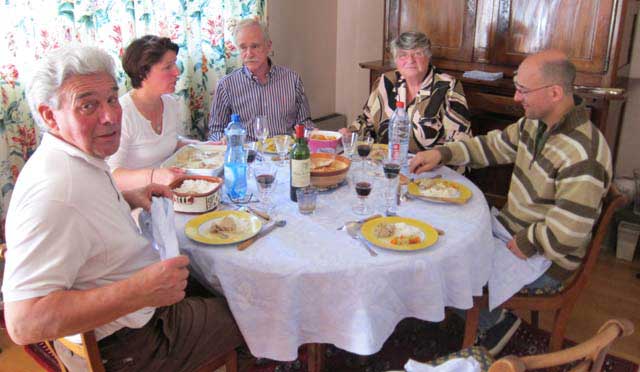
We were invited to the home of Michel and Brigitte, Caroline’s parents, in Soisy-sur-Seine south of Paris, for a traditional Sunday lunch including Caroline and her younger sister, Delphine. When we arrived, Brigitte was in the kitchen whipping up a complex meal while Michel was selecting the wines to accompany each course. Such a Sunday lunch is a French institution and the reason that for centuries French retailers resisted opening on Sundays. Their workers would not want to forego lunch “en famille.” No potluck, the Sunday midday meal is the culmination of a week’s planning and a chance for the younger generation to return home from cramped pieds-à-terre in Paris to a traditional repast and lively conversation in the countryside where they grew up.
On that first visit, my husband and chef-de-cuisine at our flat, Michael, was eager to see what Brigitte was up to in the kitchen. But the door to her inner sanctum was firmly closed and admitted no one while the complex choreography of the multiple courses was being executed. Michel had opened each of the wines, some earlier for decanting, and matched them perfectly with Brigitte’s culinary offerings. While some twenty years on I cannot recall exactly what was served that day, the overall memory is one of utmost enjoyment of the three key elements – food, wine, and conversation.
Michael attempted to reciprocate with a typical Texas feast of fried chicken, mashed potatoes, cream gravy, and pecan pie (what seemed an exorbitant dessert considering that pecans were available in tiny bags of ten shelled halves for the equivalent of about $5.00). This was accompanied by the only American wines on offer in Paris at that time, from California — sadly, not Texas. Our French friends seemed to enjoy it all and Brigitte was particularly intrigued by cream gravy — something unknown to Escoffier and the Guide Michelin’s temples of gastronomy.
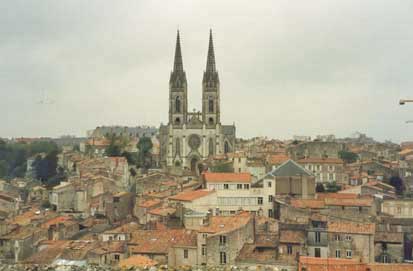
To our delight, we were invited to a number of gatherings, including with the extended family on both Brigitte’s and Michel’s sides. One such get-together involved an Eastertime trek to Niort in western France where Michel’s father, known to all as Papi, lived in a huge old house near the center of the city.
Papi was delighted that Brigitte was along, the best cook of the entire extended family, and would be preparing several meals for the group of around twenty or so. Meal planning involved a trip to Niort’s huge market with hundreds of vendors offering the freshest local produce, meats, and fish for holiday feasts. As Easter was late that year, it coincided with white asparagus season. Brigitte served it warm, accompanied by sauce hollandaise. It was Michael’s first introduction to this pale cousin of our green asparagus, much subtler in taste and with stalks so plump they have to be carefully peeled. As in the tradition of the Egyptians, Greeks, and Romans, it evoked a feast fit for the gods.
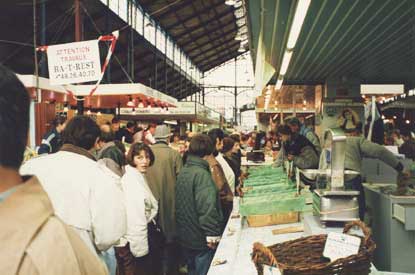
This trip also marked our conversion to the French way of thinking about food, utterly obsessed with freshness. It meant not deciding on the menu until seeing what was available at the market — choices that also drove the decision on what wines should accompany the food. Things truly did taste different, more intense yet with subtle gradations. The flavors of such seemingly mundane items as chicken, potatoes, tomatoes, strawberries, each proved a little explosion of flavor and delight. The wines were gentler, very different from the bold flavors we were used to from our years in California, and required a complete recalibration of our taste buds. They complemented each of the foods and enhanced the overall enjoyment of the meal and the company. No wonder French people linger for hours over a meal. After our visit to Niort, eating, drinking, and life in general would never be the same for us.
Papi was in charge of wine and showed us his cave or underground wine cellar where hundreds of bottles were stored. In the main part of the cellar was a tiny table with a lone bottle standing on it – a cabernet sauvignon from California which Caroline had bought Papi on one of her visits there. That was years earlier, but there it still stood, an enigma at the center of the cellar. Was Papi fearful that it might contaminate the French inventory if placed among the neatly ordered bottles, or was he waiting for just the right occasion to give it a try?
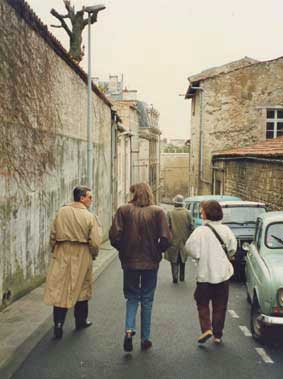
The other men also did their part, rising early each morning to head off to the boulangerie for the freshest breads and the butter-croissants. By the time they had returned, the strong coffee had just finished brewing and the butter was out on the table along with locally made jams. The trip to Niort was our first introduction to butter from the Poitou-Charentes region of west central France. We had been skeptical when Brigitte proclaimed that Beurre d’Echiré was the world’s greatest, but one bite of it on a croissant and we were devoted adherents. In those days, it was not available in Paris, so we consumed as much as we could in Niort.
Back in Paris and for the balance of our residence in France, Michael focused on absorbing the basics of French cooking from Brigitte and adopting her insistence on the freshest of ingredients. Since returning permanently to the U.S., we have tried to build on this foundation. For a while we were aided by Delphine, who came to spend several months with us and to perfect her English. She was disappointed by the lack of many basic fresh ingredients, especially vegetables and herbs, but found cause for celebration when Eatzi’s began stocking her favorite stinky cheese, Morbier, along with freshly baked baguettes that tasted almost like home.
Embracing the French approach to food and wine left us open to other aspects of French culture. For me, that meant a heightened understanding of French music, especially Jean Philippe Rameau, the composer/genius of the French Baroque. His complex harmonies and chromatic juxtapositions in the guise of graceful dance music and poignant operas made sense to me after years of skepticism grounded in the Austrian imperial hegemony of my musical upbringing.
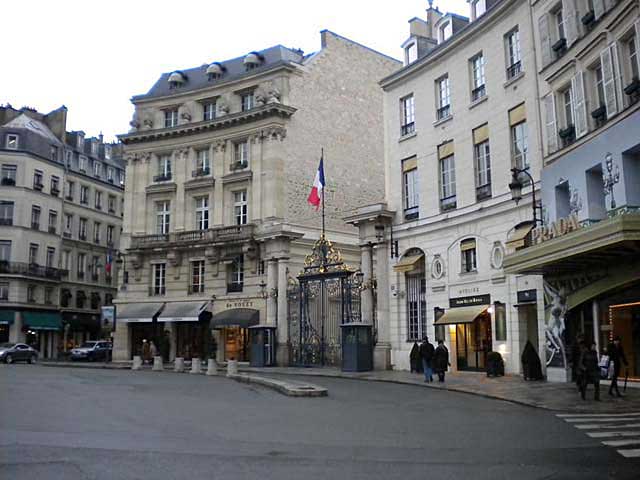
An especially magical aspect of our sojourn in Paris involved living in a flat overlooking the courtyard of the Interior Ministry on Place Beauvau. It was there that the official government band rehearsed in preparation for serenading visiting heads of state at the nearby Elysées Palace. Their renditions of La Marsaillaise never failed to cause lumps in our throats as we heard this most revolutionary of national anthems, born of a yearning for freedom and a willingness to risk life and limb to attain it. The melody and the rousing text still remind us of the close relationship our two countries have enjoyed since before the Thirteen Colonies became the United States and of the former General, the Marquis de Lafayette, whose dedication to our country extended to wanting to be interred in France with soil from the U.S. in his casket. No French blood courses through our veins, but we could not feel a greater kinship and affection for France.
The weddings of Caroline to Pierre and of Delphine to Jean took us back to Europe for two fabulous celebrations in which food was central, especially the highly architectural croque-en-bouche or “crunch in the mouth” wedding cake. These tall cones built of cream-filled pastry balls bound together with caramel are an apt metaphor for the enduring commitment of husband and wife.
After Caroline’s wedding, everyone stayed at a hotel close to the chateau where the wedding reception was held and where dancing continued until dawn. Breakfast the following morning held in store one of those typically French experiences we will always treasure.
Michael had been thinking about trying to make foie gras now that Central Market offered fresh duck liver. He figured that a breakfast table full of French foodies might be an ideal place to seek advice. It led to thirty minutes of impassioned, heated, and philosophical discussion. Nearly everyone had taken a course on foie gras preparation and was a tenacious adherent of either the slow-cooking or the quick-cooking school of thought.
Armed with perhaps more knowledge than he’d sought, Michael put his plan into action a few months later, but disaster loomed. Despite several urgent transatlantic phone calls to Brigitte and her feverish emails in French with strict instructions, Michael failed to follow them precisely and we ended up with a withered piece of pricey but awful offal.
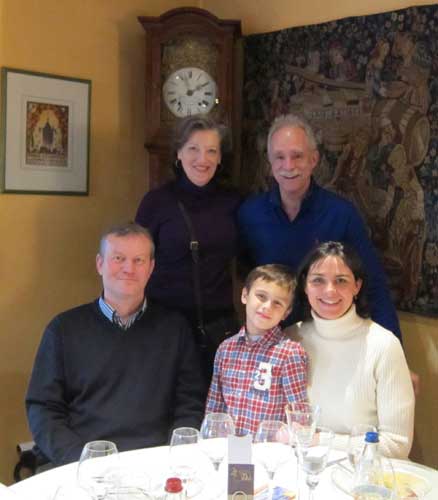
Delphine and Jean’s wedding in France was followed by a reception in Switzerland after a cruise across Lake Geneva. The trip afforded time for vacation in Provence, our first adventure to Languedoc, and the genesis of our affection for the output of small wineries whose achievements have changed the latter region’s reputation from one for plonk to a host of vintage wines worth savoring. The wine we had enjoyed most was Domaine de l’Hortus – a beautifully balanced red wine redolent of forest berries. It went perfectly with the game dishes offered at the restaurant of the Hotel Château de Floure near Carcassonne where we were staying. We drank as much as we could, sensing we would never find it back in Texas.
At the wedding reception a week later, I was seated next to Jean’s best man; a banker from Paris named Michel. I sensed that Michel was kicking himself for getting stuck next to Les Américains, especially as the rock and roll band was playing nothing but U.S. golden oldies (and giving the lie to the notion that the French hate American culture). Making polite conversation in French, Michel asked me about our recent travels and I mentioned how much we had enjoyed Languedoc, and especially the wines we had tried. When I named the Domaine de l’Hortus as our favorite, Michel pushed his chair back from the table and stared at me as though he had seen a ghost. "But that’s my favorite wine!" he exclaimed, as I sensed that les Américains were becoming les Amis. Of all the thousands of wines in France, that two people from opposite sides of the world could meet up in Switzerland and have the same favorite wine seemed utterly improbable, yet true. Thankfully, Michel knew the only wine merchant in Paris stocking Domaine de L’Hortus, so we were able to enjoy a few more bottles during our stopover there on the way back to Houston.
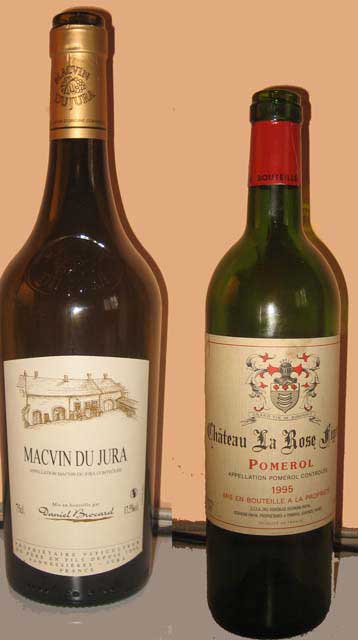
Owing to Michael’s French antiques business, we return to France at least once a year for reunions with the extended family. Brigitte still prepares memorable Sunday meals, including for our visit last fall. Dinner was preceded by Champagne (Camille Savès) setting the festive tone for the reunion with Caroline and Pierre who, along with their three young children, had just moved back to France after four years in Canada. The first course was foie gras of duck served with buttered and toasted slices of baguette. Michel paired with it a Macvin du Jura, a late harvest, small production, fortified wine from an area near the Swiss border. Lighter than the Sauternes traditionally served with foie gras, it was refreshing and delicious. The main course was a traditional French Sunday favorite, blanquette de veau, a veal stew in a creamy sauce (although such a mundane description fails to do it justice). For the wine, Michel chose Château La Rose Figeac 1995 from the Bordeaux Region (Pomerol). It tasted like just what it was – a superlative French red wine created reverently under ideal conditions and conserved until this perfect moment for consumption. In this comfortable dining room, surrounded by our friends and enjoying another sumptuous meal by Brigitte with Michel’s superb wines, we were reminded of how blessed we have been to embrace a country and a culture over the course of decades through one remarkable family, always looking forward to the next reunion.
Next time, a trip to Italy celebrating the re-discovery of Sagrantino.
The original version of this article appeared in the Spring, 2012 edition of the Quarterly Newsletter of the Wine Society of Texas, a non-profit organization dedicated to wine education and appreciation.